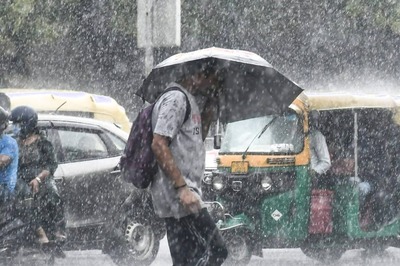
views
WASHINGTON: The Federal Reserve on Wednesday will offer its first glimpse of how a coronavirus vaccine has changed the U.S. economic outlook, and whether businesses, workers and families need more help from the central bank until inoculations and immunity are widespread.
The conclusion of the Fed’s last policy meeting of 2020 will cap a tumultuous year in which it slashed interest rates, ramped up bond purchases and took other extraordinary measures to stem the economic carnage of the pandemic.
The landscape, however, has changed dramatically since Fed policymakers held their last two-day meeting in early November, with the rollout of one COVID-19 vaccine and another one on the way almost certain to boost the outlook for 2021.
But the picture remains complicated, split between signs of a fading economic recovery and movement in Washington on further federal spending that could provide more of the support needed to outlast the economic pain of the pandemic.
U.S. retail sales for November, which usually marks the start of the Christmas shopping season, fell 1.1% as spiraling COVID-19 infections emptied stores and closed restaurants across the country. Data for October was revised to show a 0.1% drop in retail sales instead of the previously reported 0.3% increase, evidence of the blow from both the latest wave of the pandemic and the recessionary hit to household income.
At the same time, lawmakers in Congress were appearing to move closer in their negotiations for another relief package that would pump perhaps $900 billion into the pockets of households and small businesses.
In quarterly economic projections last issued in September, Fed officials at the median saw the economy growing 4% next year and the unemployment rate falling to 5.5%. Analysts expect both figures to be upgraded on Wednesday.
Less clear is what, if anything, the Fed decides to do in the meantime, including whether to focus its $120 billion in monthly asset purchases in a way that brings down longer-term interest rates even further, which could help industries like housing that are keyed to long-term mortgage loans.
It’s a move many in financial markets have called for and expect at some point, though Fed officials have for the most part said they are not yet ready to do it.
“The arguments for acting now are solid,” said Cornerstone Macro analyst Roberto Perli, adding that the choice remains “a close, meeting-time decision.”
The coronavirus is spreading rapidly at a pace of more than 200,000 new infections daily across the country, businesses face the twin challenges of renewed restrictions and more fearful consumers, and job growth is slowing – compelling reasons for the Fed to take action.
On the other hand, “the promise of vaccines and the possibility of more fiscal support … might incline the Fed to wait and see,” Perli wrote in a recent analysis.
BOND PURCHASES
The Fed is due to release its latest policy statement and economic projections at 2 p.m. EST (1900 GMT). Fed Chair Jerome Powell will hold a news conference half an hour later.
Analysts expect Powell and his colleagues to provide guidance on one important aspect of monetary policy: how much longer the Fed might continue and under what conditions it might reduce its monthly government bond purchases, a flow of support into financial markets meant to help hold down borrowing costs for consumers and businesses.
The central bank’s federal funds rate – its benchmark overnight lending rate – has been near zero since March, so the bond purchases are now its nearest tool at hand to influence the economy.
Just as rates are not expected to rise for perhaps several years, analysts expect the Fed to tie any reductions in its bond-buying to substantial improvement in the economy – likely pushing off any “taper” of its asset purchases until late next year or beyond.
Disclaimer: This post has been auto-published from an agency feed without any modifications to the text and has not been reviewed by an editor
Read all the Latest News, Breaking News and Coronavirus News here




















Comments
0 comment